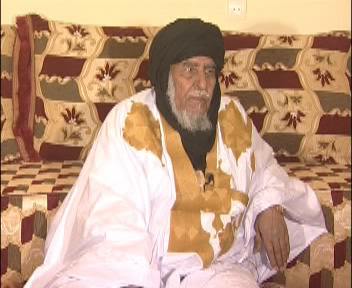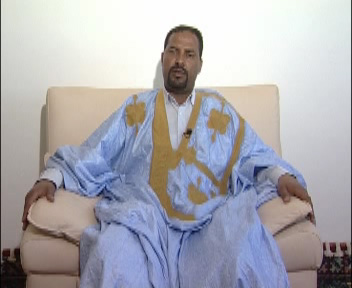 Hassani poetry is considered to be an integral part of popular poetry. Its differentia specifica lies in the fact that it is fraught with poetic meters that are measured by vowel articulation, ones which differ from each other in the way their syntactical constituents are made: ‘nasb’ (putting a noun in the accusative; or a verb in the subjunctive; ‘ghafd’ (putting a word in the genitive, for example); ‘raf’a’ (the pronunciation of a final word with a u) and ‘sukun’ (the vowellessness of a medial consonant). Some of these poetic meters, be it noted, are obsolete now.
Hassani poetry is considered to be an integral part of popular poetry. Its differentia specifica lies in the fact that it is fraught with poetic meters that are measured by vowel articulation, ones which differ from each other in the way their syntactical constituents are made: ‘nasb’ (putting a noun in the accusative; or a verb in the subjunctive; ‘ghafd’ (putting a word in the genitive, for example); ‘raf’a’ (the pronunciation of a final word with a u) and ‘sukun’ (the vowellessness of a medial consonant). Some of these poetic meters, be it noted, are obsolete now.

 The great professor and poet Badi Ould Mohammed Salem defined Hassani poetry thus: “it is a select type of talk taken from the common tongue and the local idiom. It is governed by certain rules that are in fact akin to the five rules of the Shari’ a (Islamic law); namely, the mandatory, the recommended, the permissible, the reprehensible and the forbidden.
The great professor and poet Badi Ould Mohammed Salem defined Hassani poetry thus: “it is a select type of talk taken from the common tongue and the local idiom. It is governed by certain rules that are in fact akin to the five rules of the Shari’ a (Islamic law); namely, the mandatory, the recommended, the permissible, the reprehensible and the forbidden.
On the other hand, it is a form of prose that serves as the subject matter for the poet, who shapes up and weaves, so to say, and then thins it out in some corner. In some other corner, s/he would split it, and defame it so much so that s/he would cull from it a full-blown body that admits of no addition or diminution, one which takes up its position among all other creatures, having as it does beauty as well as ugliness and being as it is both long and short.

Like any other type of poetry, be it in dialectal or standard Arabic, Hassani poetry has its specific importance. And despite the fact that its writers take pride in its ability to go beyond the confines of standard poetry, vernacular Hassani poetry is fraught with terms in common use in standard Arabic, nay, with thoroughly meaningful sentences, in addition to lexical borrowings from other foreign languages, not to mention the fact that it draws on the Islamic religion, Quranic suras, prophetic sayings as well as on Arabic poetry that spans all ages.
Several people excelled in the writing of Hassani poetry. There is in fact a specific category of people who, in addition to the poets themselves, are adept at reciting this kind of poetry. These consist mainly of a group of singers who are in Hassani parlance called ‘Ikaoun,’ who, along with a number of eminent poets, engage in the criticism of poetry in order to sift good from mediocre Hassani poetry. One could in fact find some poets who learn by heart some poetry other than their own.
One of the difficulties that Hassani poetry suffers from is that it is scarcely recorded, which tosses it into confusion, distortion and loss. Such a situation, be it noted, obtains up to the present.
Of the salient objectives of popular Hassani poetry, the following is in order:
1. What is considered to be permissible: a kind of poetry that is complete in rhyme scheme, and admits of no addition or diminution: implication, intransitivity, assonance and extraction, outlay, nun-nation, proper as well as reverse circumlocution.
2. What is reprehensible in Hassani poetry: ‘zai’ (with stress on z ), in addition to the use of words that are foreign to the Hassani dialect, especially from standard Arabic, the reason being that poets consider such a use as being a gesture of weakness on the part of the poet. Generally, such a type of mixture between Hassani dialect and standard Arabic idiom is not favourable to the man-in-the-street.
3. The taboo; or what is forbidden in Hassani poetry: “adla’a,” which means that the parts of a poem are incompatible in terms of the lexical items used, which is called ‘taflouit’; they are either superfluous or lacking, in addition to the fact that both the overuse of and excessive parsimony in words can lead to confusion and, by the same gesture, to loss of meaning. This is called ‘la’war’ or ‘al’ur’.
4. Duty: This lies in what is commonly known in Hassani poetry as the observance of the rhyme scheme, and the so-called ‘kalf’ (poetic line), ‘attal’a’ (the poem itself); or ‘assabba’ (a particular poem) ought also to observe the rules underpinning the rhyme scheme, and no ‘watr’ (the existence of an irregular verse) is acceptable.
5. What is recommended is that the ’tal’a’ (poem) should have a ‘kaaf’ (a line of poetry) that is tightly linked to the poem in terms of both meaning and structure, whether it occurs at the beginning of the poem, where it serves as an explicative apposition; or at the end of the poem, where it serves to undermine, so to speak, its meaning. Moreover, it is worthy to note that it is highly preferable that the writing of Hassani poetry be done in the local dialect, not in standard Arabic, the local dialect being here a true aesthetic measure of this type of poetry.
 The meter and rhyme scheme of Hassani poetry have gone through two important phases:
The meter and rhyme scheme of Hassani poetry have gone through two important phases:
Firstly- Prior to music: This is the stage where poetry was considered as a type of quite distinguished prose; the poetic lines were not measured against each other, and no room could be had for ‘attal’a’ (the poem itself), and were it to exist, it showed only one, maybe two, three or even four, rhymes schemes. Besides, the meter governing a particular line was a matter of vowel point; that is, whether it is short, long or rounded, without any consideration for letters of the alphabet.
Hassani poetry remained as such for long period of time, following which a new phase began to emerge where poetry came to a higher stage of maturity. In fact, at this stage, poets began to limit the rhyme scheme to whatever consonants are in harmony with the musical rhythm of the poem as a whole. Another characteristic came into being which places greater importance on the equivalence of lines, and the fact that they be measured against each other as evenly as possible, any addition or diminution being out of place. In this way, the rhyme scheme began to be firmly stabilized and therein appeared what is known as ‘alhumr’ and ‘al’qrab,’ which will remain as the foundation of any poetic meter or rhyme scheme in Hassani poetry.
Secondly, the emergence of music represented a novel impetus for the advancement of Hassani poetry towards a more sophisticated phase, as poets were somehow compelled to accompany their lyrics with musical rhythm. A situation such as this stipulated that any type of poetry that is not in one way or another spiced up by a musical rhythm became, purely and simply, unacceptable. Thus, music started to shape up poetry itself. It in fact helped in forging, so to say, poetic meter in Hassani poetry along the lines of commonly accepted meter in Arabic poetry at large.
More particularly, there emerged into being the idea that each phase had its specific rhythm and musicality, even its own specific poetry, all of which could not be used under other different circumstances. At this particular point, ‘attal’a’ was added to the overall structure of a poem, not to mention the fact that consonance increased from one instance into eight ones. It is worth mentioning here that the poetry in vogue in the previous phases was still recognized. Its different meters were all compiled into one sole meter which was known as the all-encompassing meter. There existed in fact a number of other meterical patterns such as ‘arrasm’, ‘al massaar’i,’ ‘al’asir,’ ‘ashtan,’ ‘azmoul,’ ‘atrous,’ and ‘al wakidi,’ to name but a few. However, the development that occurred in the area of popular poetry led in general to dispensing with a number of these metrical patterns, and to preserving only the ones that are more familiar now.
1. Ba’amrane: The ‘k’ sound in Ba’amrane is structured around ‘seven’ consonantal sounds, one which move from being a dynamic to static state .
2. Merimida: It is a meter in close connection to the way Ba’amrane’s versification is patterned, as it is also structured around seven consonantal sounds. It, nonetheless, differs in the way the consonants are put together, for it begins with two consonant clusters followed by one consonant, and at times with one consonant only.
3. Assaghir (lit. the little one), one of the characteristics of which we have already pointed out. Its major characteristic is that it is not measured by its first part only, but needs to be considered from the point of view of the first two parts, as it is built around seven consonantal sounds in the first part, five in the second and never ends but with a medial consonant. It is also characterized by the fact that after each set of consonants, a medial consonant appears to be necessary, in addition to the fact that its third sound needs to be medial, too.
4. Lbir: It is relatively wrought along the lines of ‘albtit’, despite the fact that it shows one consonantal sound less in comparison; the poetry that follows ‘lbtit’ s metrical design includes seven consonants, and is characterized, at least in its first part, by what is known in Hassani poetry as ‘lehrache’. Its second part, however, is toned down as opposed to the first part, another characteristic that distinguishes it from ‘lbtit’. Under some specific circumstances, it could turn into what is commonly known as ‘btatrateq’ or ‘mimaiat lbir’.
5. Lbtit : it is of two kinds: what is known as ‘incomplete lbtit,’ which is written with seven consonants, and ‘complete lbtit,’ which has eight consonantal sounds. In general, ‘complete lbtit’ is taken to be more secure in comparison with the metrical patterns in use by Hassani poetry, the reason being its inclusion of a great number of consonantal sounds. As to the rationale behind its division into two parts, one complete and the other incomplete, it is the fact that poetic musicality treats it as being itself of an essentially musical rhythm. One in fact finds two different appellations for the same meter: ‘a’adal’ and ‘biqi’.
